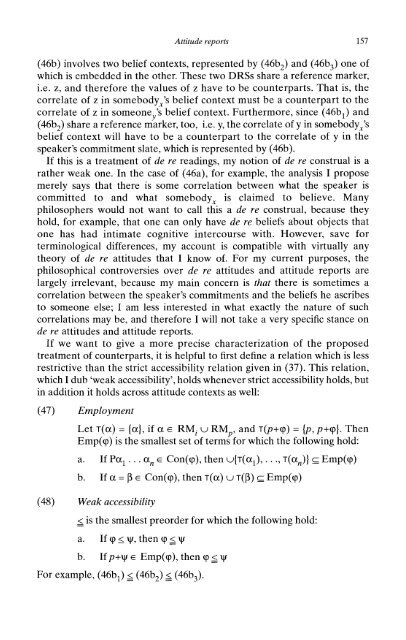Presuppositions and Pronouns - Nijmegen Centre for Semantics
Presuppositions and Pronouns - Nijmegen Centre for Semantics
Presuppositions and Pronouns - Nijmegen Centre for Semantics
You also want an ePaper? Increase the reach of your titles
YUMPU automatically turns print PDFs into web optimized ePapers that Google loves.
Attitude reports 157<br />
(46b) involves two belief contexts, represented by (46b 2 ) <strong>and</strong> (46b 3 ) one of<br />
which is embedded in the other. These two DRSs share a reference marker,<br />
i.e. z, <strong>and</strong> there<strong>for</strong>e the values of z have to be counterparts. That is, the<br />
correlate of z in somebody^ x's belief context must be a counterpart to the<br />
correlate of z in someone/s 's belief context. Furthermore, since (46b l 1 ) <strong>and</strong><br />
(46b 2 ) share a reference marker, too, i.e. y, the correlate of y in somebody^'s x's<br />
belief context will have to be a counterpart to the correlate of y in the<br />
speaker's commitment slate, which is represented by (46b).<br />
If this is a treatment of de re readings, my notion of de re construal is a<br />
rather weak one. In the case of (46a), <strong>for</strong> example, the analysis I propose<br />
merely says that there is some correlation between what the speaker is<br />
committed to <strong>and</strong> what somebody^, somebodyx is claimed to believe. Many<br />
philosophers would not want to call this a de re construal, because they<br />
hold, <strong>for</strong> example, that one can only have de re beliefs about objects that<br />
one has had intimate cognitive intercourse with. However, save <strong>for</strong><br />
terminological differences, my account is compatible with virtually any<br />
theory of de re attitudes that I know of. For my current purposes, the<br />
philosophical controversies over de re attitudes <strong>and</strong> attitude reports are<br />
largely irrelevant, because my main concern is that there is sometimes a<br />
correlation between the speaker's commitments <strong>and</strong> the beliefs he ascribes<br />
to someone else; I am less interested in what exactly the nature of such<br />
correlations may be, <strong>and</strong> there<strong>for</strong>e I will not take a very specific stance on<br />
de re attitudes <strong>and</strong> attitude reports.<br />
If we want to give a more precise characterization of the proposed<br />
treatment of counterparts, it is helpful to first define a relation which is less<br />
restrictive than the strict accessibility relation given in (37). This relation,<br />
which I dub 'weak accessibility', holds whenever strict accessibility holds, but<br />
in addition it holds across attitude contexts as well:<br />
(47) Employment<br />
Let T(a) T(oc) = {a}, if a E e RMi RM- u RM p ,' <strong>and</strong> T(P+














